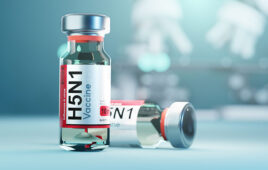
Treatment of tuberculosis involves a combination of several drugs, sometimes including drugs from a class known as fluoroquinolones. Using computer simulations, scientists have shown that the fluoroquinolone known as moxifloxacin may be superior to two other commonly used fluoroquinolones, according to a new paper in PLOS Computational Biology.
Tuberculosis infects millions of people every year and requires at least 6 months of treatment with multiple drugs. This treatment can include one of three fluoroquinolones: moxifloxacin (MOXI), levofloxacin (LEVO), or gatifloxacin (GATI). However, existing data from clinical trials and animal studies are inadequate to determine which is best or if all three are equivalent.
In the new study, Elsje Pienaar and colleagues at the University of Michigan in Ann Arbor and Rutgers developed a computer model to simulate the effects of the three drugs on granulomas — clusters of host cells and bacteria that develop in the lungs of tuberculosis patients. The computer model incorporates experimental data on the three drugs, as well as extensive knowledge on the chemistry of their activity.
The research team used the computer model to simulate treatment with each of the three drugs and compared them according to multiple criteria. In the simulations, MOXI appeared to be superior to both LEVO and GATI because it killed bacteria in granulomas more quickly, and it performed better when the simulated patients missed doses. LEVO killed bacteria more quickly than GATI. However, all three drugs were unable to kill bacteria at the very center of the granulomas.
“The exciting thing about this study is that we are able perform a side-by-side comparison of fluoroquinolones in identical infections,” Pienaar says. “The potential practical application of our findings is to guide selection of individual fluoroquinolones for tuberculosis treatment.”
Pienaar says that the predictions of the simulations are now being tested in animal experiments. The team is also enhancing the computer model to test fluoroquinolones alongside other tuberculosis drugs, which could help narrow down the best possible drug combinations for tuberculosis treatment.
Filed Under: Drug Discovery



